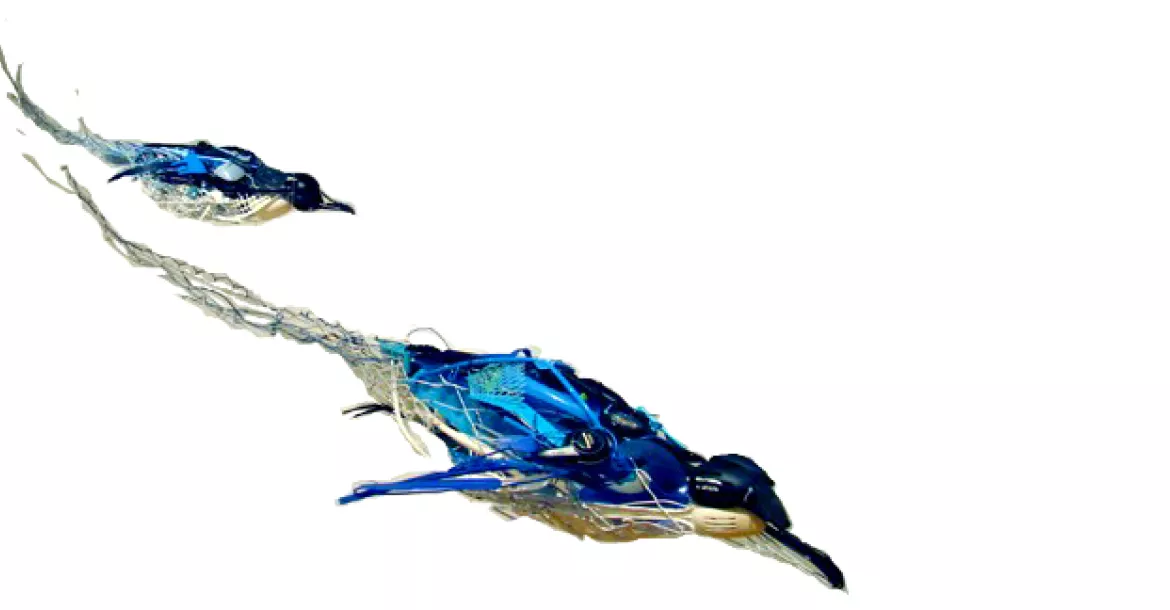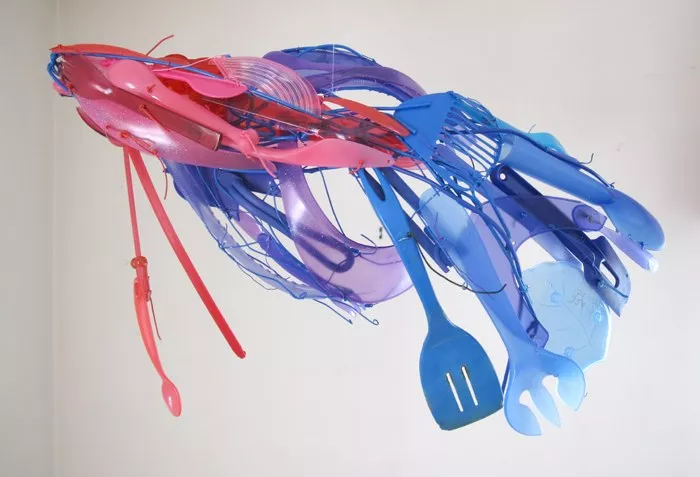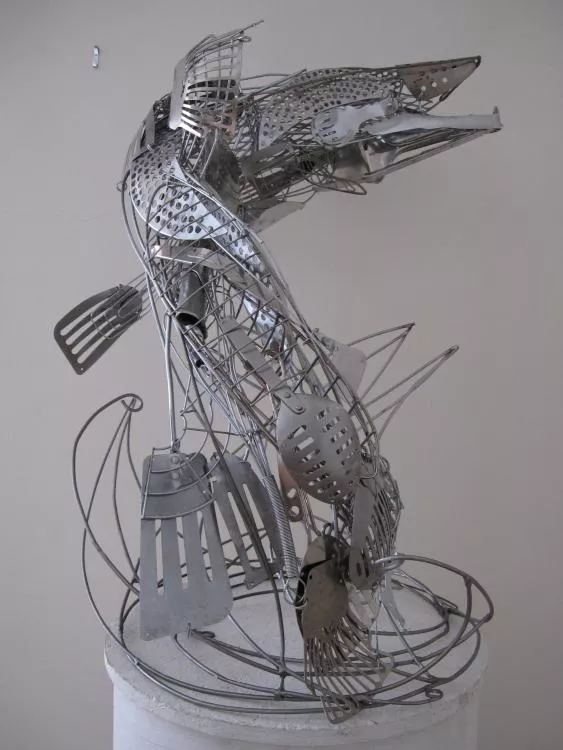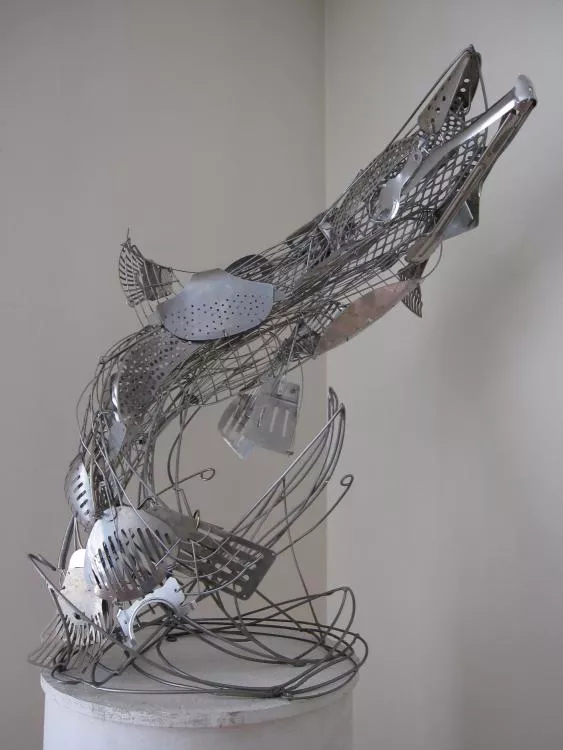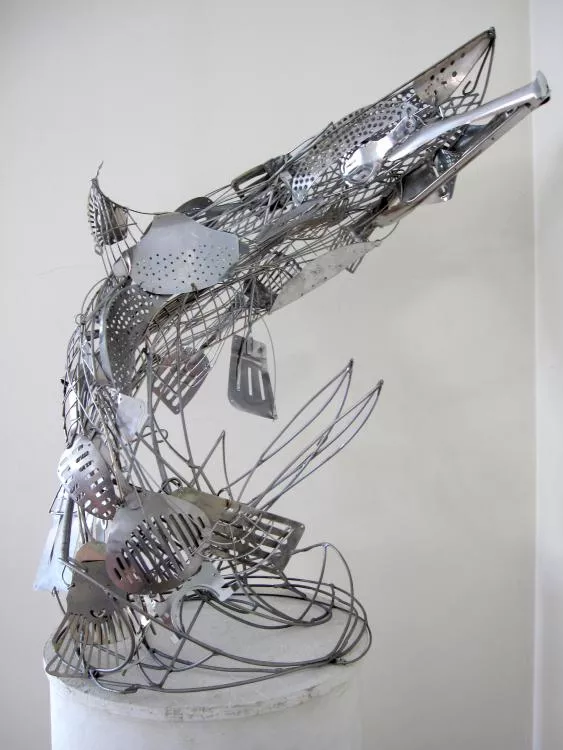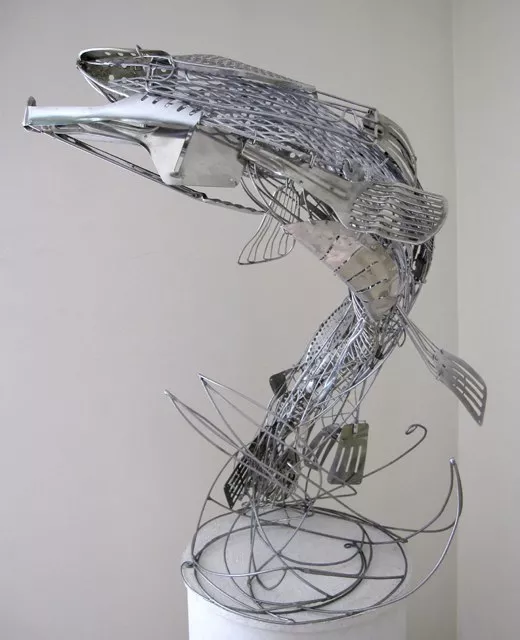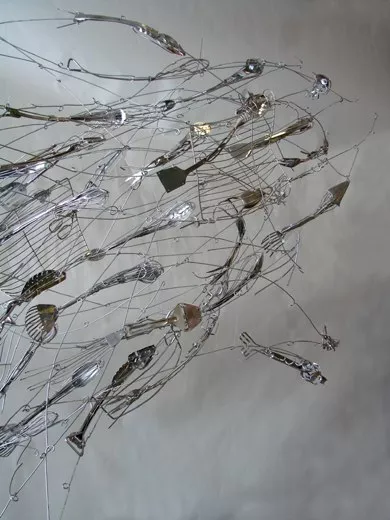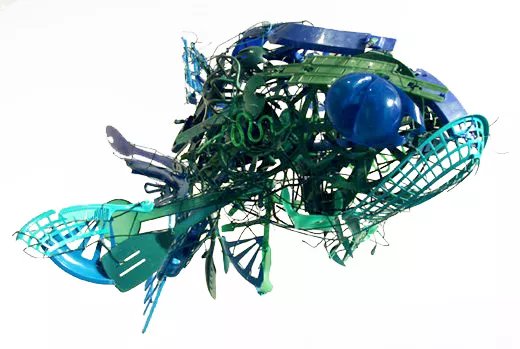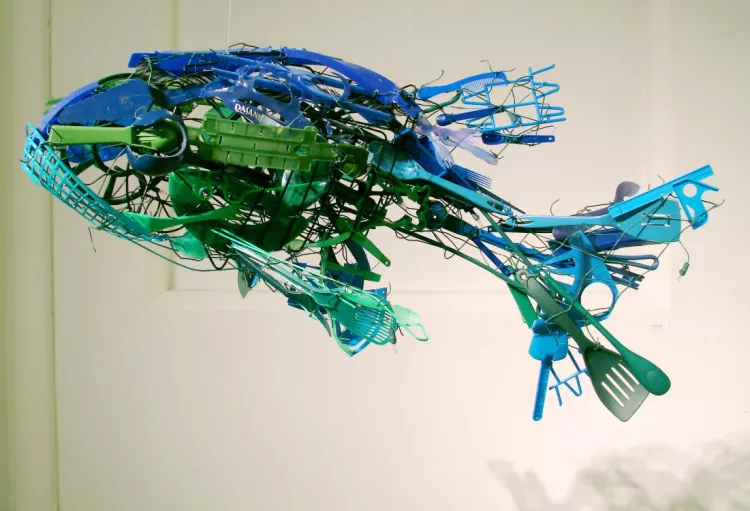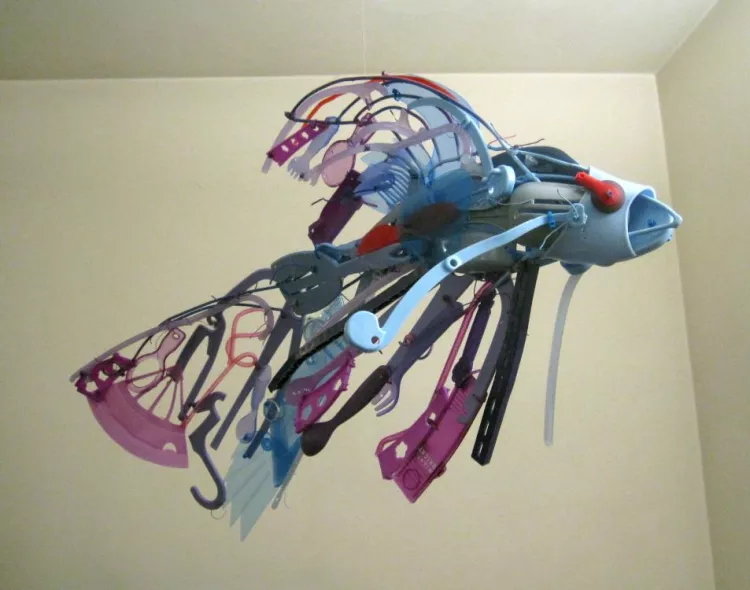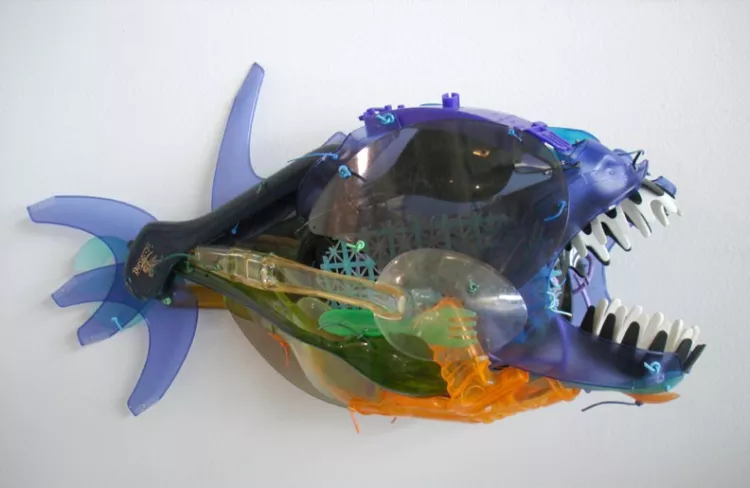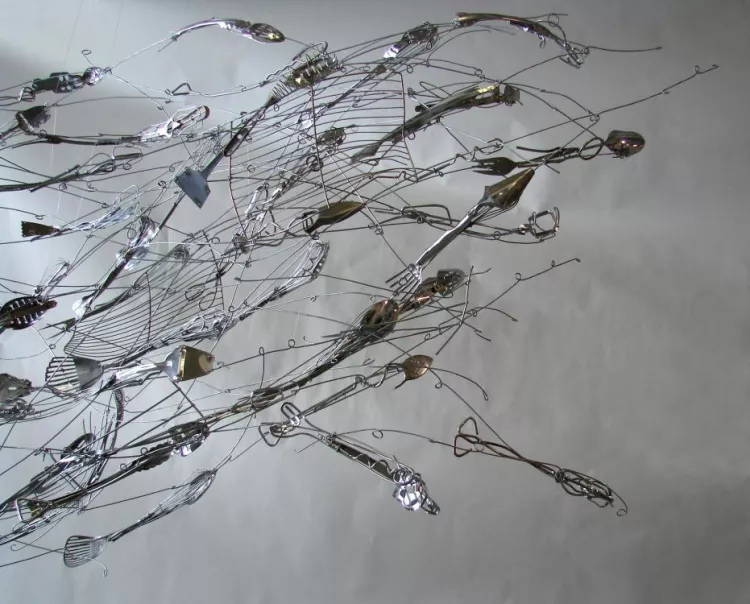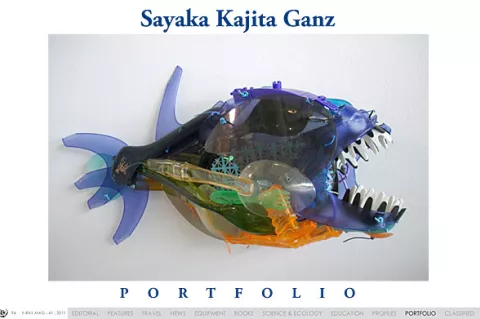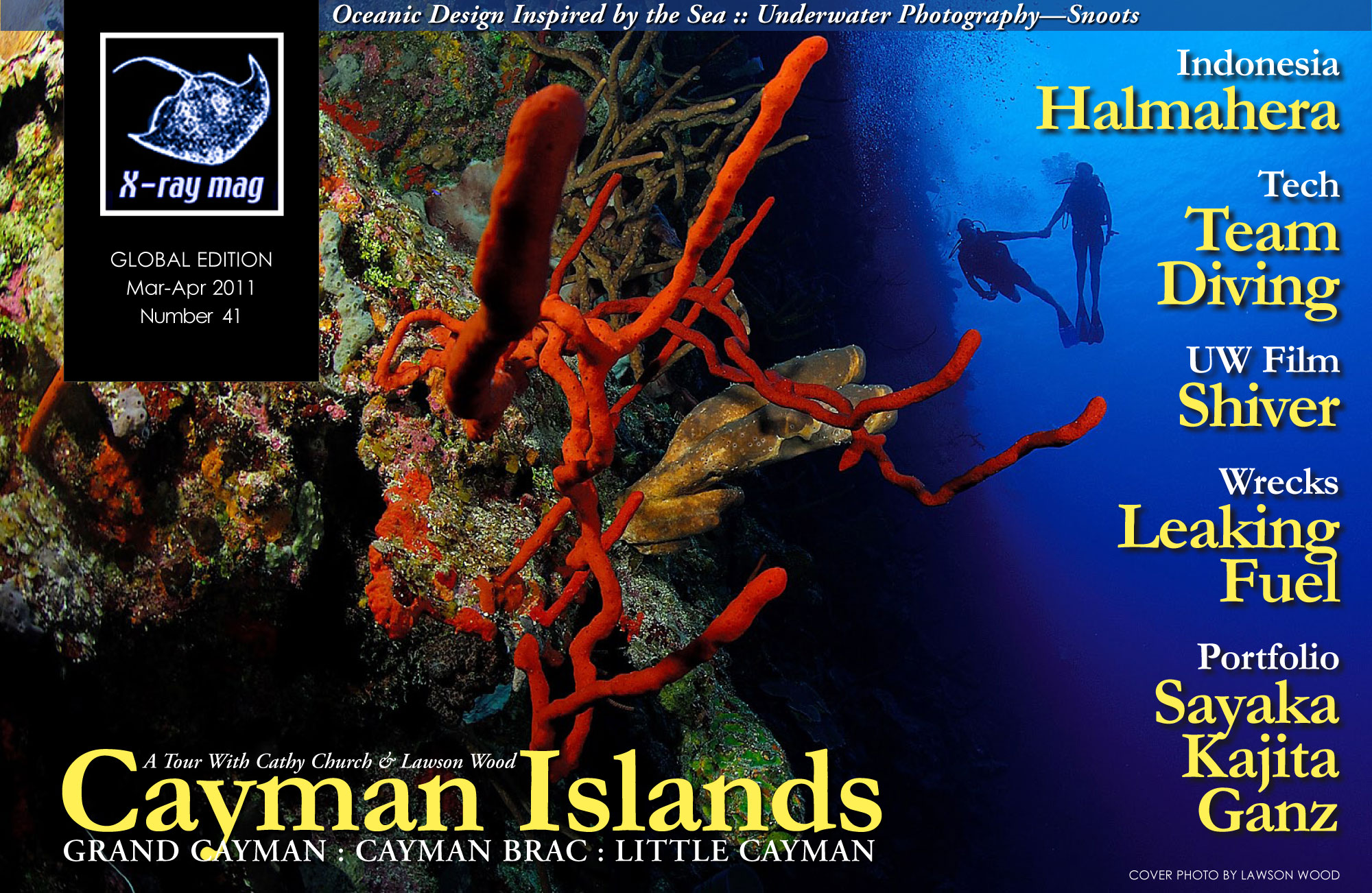"My working process is reminiscent of my experiences growing up in several different countries, of being disconnected from the place I was born. Then, I began searching for a new community where I truly belong," said Ganz. "I find discarded objects from peoples’ houses and give them a second life, a new home."
Contributed by
Ganz explains: "For my sculptures I use plastic utensils, toys and metal pieces among other things. I only select objects that have been used and discarded. The human history behind these objects gives them life in my eyes. My goal is for each object to transcend its origins by being integrated into an animal form that seems alive. This process of reclamation and regeneration is liberating to me as an artist. By building these sculptures I try to understand the human relationships that surround me. It is a way for me to contemplate and remind myself that even if there is conflict right now, there is a way for all the pieces to fit together. That even if some people don’t feel at home here and now, there is a place where they belong and that they will eventually find it."
X-RAY MAG: Tell us about yourself and your work. How did you develop your unique style and what is the philosophy or mission behind your sculptures?
SKG: I was born in Yokohama, Japan. My family moved to Sao Paulo, Brazil, when I was nine years old, and we lived there for almost five years. We went back to Japan when I was 13, then moved to Hong Kong when I was 17. I graduated from high school in Hong Kong and came to the United States to attend university.
Up to high school, I never graduated from the same school I started in. All these relocations have affected my thinking, made me flexible and also made me crave a sense of belonging. I get great comfort from fitting things together, perhaps partially because of these experiences.
My philosophy is that beauty is all around us, but sometimes a shift in perspective is necessary to find it.
X-RAY MAG: Where do you get your inspiration?
SKG: I get the inspiration from the discarded objects themselves. The human history behind each piece is very interesting—someone designed and created this object, someone used and later discarded it. I am also inspired by nature and life energy of animals—the motion, wind, water current, waves and time.
X-RAY MAG: Why did you choose fish as a subject?
SKG: I love the fluidity of their form and motion, both individually and in a school. I try to focus my attention on the motion and direction rather than the details of scales and fins, so that the viewer can share the sense of life energy.
X-RAY MAG: Why do you use the materials you use and where do you get them?
SKG: I collect plastic objects from thrift stores, mostly here in Fort Wayne, but when I’m on the road, I make a detour to visit other locations as well. I never buy new objects, only second-hand objects from thrift stores or by donation. I have them sorted by color in about 30 storage bins in the basement, and the collection is an on-going process. I start a project when I have enough objects of the right color.
X-RAY MAG: Tell us about your training and education. Who has inspired you, artistically speaking?
SKG: I went to Indiana University Bloomington for BFA in Print-making, and Bowling Green State University (Ohio) for MFA in 3D Art. My greatest inspiration growing up was my mother. More recently, the artists I admire are Choe U-ram, Theo Jansen, Edouard Martinet, Tara Donovan, Deborah Butterfield, Jean Shin, Tomoko Konoike and my husband Christopher Ganz.
My mother had many craft hobbies when I was a child. She would always encourage me to draw and take me to kids’ craft project booths at department stores whenever we went shopping to Yokohama, a big city about 20 minutes away from where we lived. Because of her hobbies, I always had scrap materials to experiment with, and I think that’s how I developed the taste for using found objects.
Theo Jansen and Choe U-ram are both kinetic artists. I admire how their creations seem so alive with the beautiful fluid motion.
Edouard Martinet uses metal objects very similarly to how I use plastic, but his work is very clean, tight and flush in joints, and he makes the objects seem as if they have been destined to become his sculpture all along.
Tara Donovan uses thousands of the same common household objects to create beautiful and monumental installations. I admire her vision.
Deborah Butterfield, famous for her beautiful horse sculptures, has been my inspiration since when I was using scrap metal for materials. I had already started making animal forms when I first saw her work. I love her work, but she also inspired me to go and look for my own style instead of trying to make my work more like hers.
Jean Shin uses discarded materials, usually hundreds or thousands of the same, so in that sense, her work is similar to Tara Donovan’s. Her philosophy is very intriguing, however, she tries to explore the nature of each object both in form and in intended function.
Tomoko Konoike is a Japanese female artist who makes mysterious fantastic drawings, sculpture, animation and more. She has created a whole world of her artistic vision, and she works in so many mediums.
My husband Christopher Ganz does large-scale charcoal drawings that depict multiple self-portraits in various (industrial, consumer, medical, to name a few) situations. He is also a great printmaker; he teaches printmaking at a university here in Fort Wayne. His prints are smaller and sometimes more experimental versions of his drawings. Chris is my best advisor, critic, friend and encourager in art. We share the basement studio in our house, so we are constantly bouncing ideas off each other.
X-RAY MAG: Are you a scuba diver or a snorkeler? If so, where have you dived and what is your favorite place to dive?
SKG: No. I have gone snorkeling once when I was a child. I would LOVE to try scuba diving.
X-RAY MAG: Tell us your relationship to the underwater world, the sea and the reef. What inspires you about the ocean and the underwater realm?
SKG: I grew up going to the beach often and digging around or exploring to look for sea creatures. I was always more interested in finding them than in swimming. What intrigues me about the underwater realm is that you can see and feel the life energy of not just the individual fish, but the entire school, the entire ocean current, the entire planet.
X-RAY MAG: What are your thoughts on the role of art in conservation and environmental awareness?
SKG: I want my work to offer an alternative to throwing away unwanted household objects.
X-RAY MAG: Why art? Why do you think art is important? What do you want to say with your art?
SKG: Art can inspire viewers into wanting to take action, wanting to see more, wanting to find solutions. This is important because sense of duty and guilt can only take us so far.
X-RAY MAG: What future projects do you have planned?
SKG: I am currently working on a collaborative project with my friend Jim Merz who is a kinetic artist. It will be a 20-foot-long spinning LED chandelier made of goblets and bowls from the thrift shops. I’m in a group exhibition in Washington D.C. in March; I have a commission To create four horse sculptures at the Isle of Man in October; and I might also make a wall mosaic for the Monterey Bay Aquarium using plastic debris from the ocean in 2012.
Incidentally, I have visited Denmark three times because my aunt, uncle and cousin live in Copenhagen. I am working with my cousin’s company Ayanomimi www.ayanomimi.com and I hope to have an opportunity to show my work in Copenhagen in the near future.
X-RAY MAG: Do you teach art? If so, what is your approach?
SKG: I teach drawing and design (3D) at Indiana University - Purdue University Fort Wayne. My teaching philosophy is to help students get to know themselves and amplify their abilities to become more like themselves, not more like me.
To learn more about Sayaka Kajita Ganz or to purchase art and order commissions, visit: www.sayakaganz.com. ■
What intrigues me about the underwater realm is that you can see and feel the life energy of not just the individual fish, but the entire school, the entire ocean current, the entire planet.
— Sayaka Kajita
Published in
- Log in to post comments

